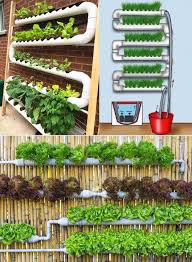Hydroponics is a method of growing plants without soil, using a nutrient-rich water solution instead. Derived from the Greek words “hydro” (water) and “ponos” (labor), hydroponics has gained significant popularity, especially as water conservation becomes essential and people seek alternative growing methods. Here’s how you can set up your own hydroponic system at home.
Benefits of Hydroponics:
- Faster Plant Growth: Hydroponic plants can grow up to 25% faster and yield up to 30% more than those grown in soil due to better nutrient and water access.
- Water Conservation: Hydroponics uses up to 90% less water compared to traditional soil-based farming, making it a sustainable option.
- Space-Saving: Ideal for urban environments with limited space, hydroponics allows you to grow plants indoors or on small patios.
- Reduced Risk of Disease: Without soil, the risk of soil-borne diseases and pests is greatly minimized.

Types of Hydroponic Systems:
- Wick System: Nutrient solution is drawn into the growing medium using wicks.
- Deep Water Culture (DWC): Plants are suspended in a nutrient-rich water solution, with an air pump providing oxygen to the roots.
- Nutrient Film Technique (NFT): A thin stream of nutrient solution flows over plant roots in a slanted tray.
- Ebb and Flow (Flood and Drain): Periodic flooding and draining of the grow tray with nutrient solution.
- Drip System: Nutrient solution is dripped directly onto the base of each plant.
- Aeroponics: Plant roots are suspended in air and misted with nutrients.
Building a Basic Deep Water Culture (DWC) System:
Materials Needed:
- Large container or storage tub (for the reservoir)
- Aquarium air pump and air stone
- Hydroponic nutrients
- pH control kit
- Net pots or cups
- Growing medium (e.g., hydroton or rock wool)
- Seeds or seedlings
- Container lid or cover
Steps to Set Up:
- Reservoir Setup: Fill the container with water, leaving about an inch from the top. This is your nutrient reservoir.
- Air Supply: Attach the air stone to the air pump and place it in the reservoir. The air stone will provide oxygen to the plant roots.
- Prepare the Lid: Cut holes in the container lid large enough for the net pots. Ensure the plants will be partially submerged in the nutrient solution.
- Planting: If using seeds, plant them in the growing medium within the net pots. For seedlings or cuttings, transplant them into the net pots.
- Nutrient Solution: Mix the appropriate amount of hydroponic nutrients into the water as per the instructions. Use the pH control kit to adjust the pH to the recommended level.
- Maintenance: Regularly check the pH and nutrient levels, adjusting as necessary. Monitor water levels and top up the reservoir when needed.
Tips for Success:
- Lighting: Plants require sufficient light for growth. Consider LED grow lights if natural sunlight is insufficient.
- Temperature: Maintain a stable temperature between 68°F to 72°F (20°C to 22°C) for optimal plant growth.
- Monitor Regularly: Check plants daily for signs of nutrient deficiencies, pests, or diseases.
- Keep It Clean: Clean your system regularly to prevent the buildup of harmful bacteria or algae.
Conclusion:
Creating your own hydroponic system at home is a rewarding and sustainable way to grow plants, even in small or urban spaces. With careful attention and the right setup, you can enjoy fresh, homegrown produce year-round. Happy gardening!
